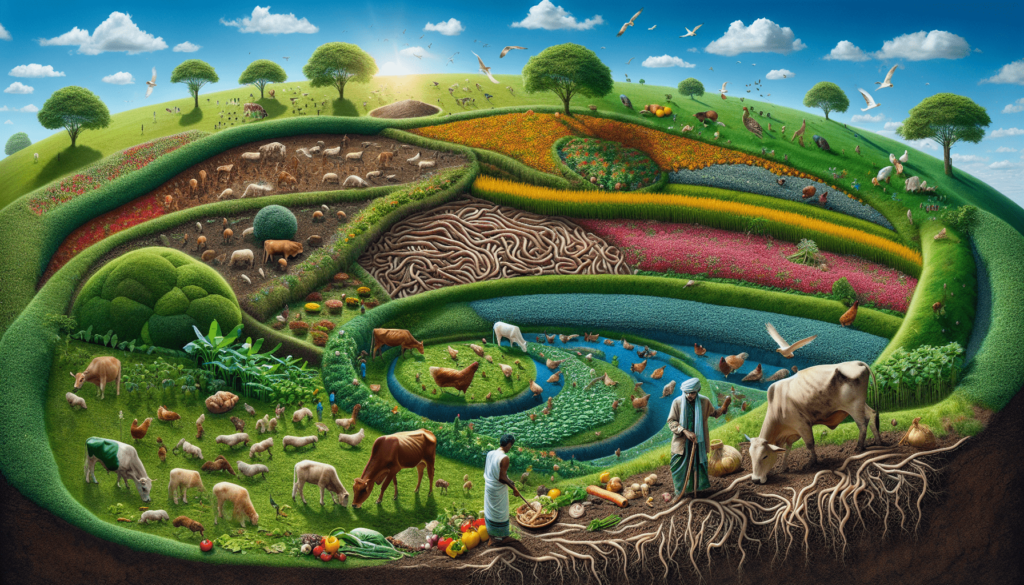In the world of healthy living, where food serves as medicine and prevention holds great importance, the concept of regenerative agriculture has emerged as a treasure trove of knowledge. This article uncovers the secrets and benefits of regenerative agriculture – a practice that goes beyond organic farming methods to restore and enhance ecosystems, improve soil health, and promote biodiversity. By embracing regenerative agriculture, you not only contribute to a sustainable food system but also unlock the potential for vibrant health and vitality. Get ready to delve into the fascinating world of regenerative agriculture and discover how it can revolutionize the way we grow and consume food.

What is Regenerative Agriculture?
Regenerative agriculture is a holistic approach to farming that focuses on restoring and improving the health of the soil, increasing biodiversity, conserving water, sequestering carbon, and building resilience to climate change. It goes beyond traditional organic farming practices by not only avoiding the use of synthetic chemicals but also actively working to regenerate and enhance the natural resources of the farm ecosystem. Regenerative agriculture aims to create sustainable and regenerative farming systems that benefit both the environment and the farmers.
Definition of regenerative agriculture
Regenerative agriculture can be defined as a farming system that aims to restore and enhance the health of the soil, improve biodiversity, conserve water, and sequester carbon, while also improving resilience to climate change. It involves practices such as cover cropping, crop rotation, no-till farming, managed grazing, agroforestry, and compost and organic matter management.
Principles of regenerative agriculture
The principles of regenerative agriculture include focusing on soil health, biodiversity, water conservation, carbon sequestration, and resilience to climate change. These principles guide farmers in implementing practices that work in harmony with nature and ensure the long-term sustainability of their farms. By adopting these principles, farmers can create agricultural systems that are not only productive but also environmentally friendly and economically viable.
How regenerative agriculture differs from organic farming
While both regenerative agriculture and organic farming aim to minimize synthetic inputs and prioritize environmental sustainability, regenerative agriculture goes a step further by actively working to regenerate the resources of the farm ecosystem. Organic farming focuses primarily on avoiding the use of synthetic chemicals, whereas regenerative agriculture seeks to restore and improve the health of the soil, increase biodiversity, conserve water, and sequester carbon. Regenerative agriculture also emphasizes the principles of soil health and resilience to climate change, which are central to its approach.
Benefits of Regenerative Agriculture
Restoring soil health
One of the key benefits of regenerative agriculture is its ability to restore and improve the health of the soil. By implementing practices such as cover cropping, crop rotation, and compost and organic matter management, regenerative farmers can increase the organic matter content of the soil, improve its structure, and enhance its nutrient-holding capacity. Healthy soil not only supports the growth of crops but also promotes beneficial soil microorganisms and reduces the need for synthetic inputs.
Increasing biodiversity
Regenerative agriculture promotes the conservation and enhancement of biodiversity on the farm. By diversifying crops and implementing practices such as agroforestry and habitat restoration, farmers can create habitats for wildlife, insects, and beneficial organisms. Increased biodiversity helps to maintain a balanced ecosystem, improves pollination and pest control, and enhances overall farm resilience.
Enhancing water quality and conservation
Regenerative agriculture practices, such as no-till farming and cover cropping, help to improve water quality and conservation. No-till farming reduces soil erosion and runoff, preventing sediment and pollutants from entering water bodies. Cover cropping helps to reduce water evaporation, improves water infiltration, and reduces the need for irrigation. These practices contribute to better water quality and conservation, benefiting both the farm and the surrounding environment.
Sequestering carbon
One of the significant advantages of regenerative agriculture is its ability to sequester carbon from the atmosphere and store it in the soil. Practices like cover cropping, crop rotation, and compost application increase the organic matter content of the soil, which not only enhances soil health but also helps to capture and store carbon dioxide. By sequestering carbon in the soil, regenerative agriculture contributes to mitigating climate change and reducing greenhouse gas emissions.
Improving resilience to climate change
Regenerative agriculture helps to build resilience to climate change by enhancing the health and function of the farm ecosystem. Healthy soils, increased biodiversity, and improved water management contribute to the farm’s ability to withstand extreme weather events such as droughts and floods. Regenerative practices also promote efficient nutrient cycling and reduce the reliance on synthetic inputs, making farms more resilient in the face of changing climate conditions.
Regenerative Agriculture Techniques
Cover cropping
Cover cropping involves planting crops, primarily for the purpose of covering and protecting the soil during periods when main cash crops are not growing. Cover crops help to prevent soil erosion, improve soil structure, suppress weeds, and provide additional organic matter to the soil when they are incorporated.
Crop rotation
Crop rotation involves growing different crops in a sequence on the same piece of land over time. This practice helps to break the cycle of pests and diseases, improve soil fertility, enhance nutrient cycling, and reduce the need for synthetic inputs. Through crop rotation, farmers can diversify their crop production and promote overall farm resilience.
No-till farming
No-till farming refers to a method of planting and growing crops without disturbing the soil through tillage. Instead of plowing or tilling the soil, farmers use specialized equipment to plant crops directly into the residue of the previous crop. No-till farming helps to reduce soil erosion, improve water infiltration and retention, preserve soil structure, and promote beneficial soil organisms.
Managed grazing
Managed grazing involves strategically rotating livestock through different pastures or grazing areas. By allowing livestock to graze for a short period and then moving them to a new area, farmers can avoid overgrazing, promote healthy plant growth, and improve nutrient cycling. Managed grazing also helps to restore grasslands, enhance biodiversity, and increase carbon sequestration in grazing areas.
Agroforestry
Agroforestry is a practice that involves integrating trees, crops, and livestock on the same piece of land. By planting trees in agricultural fields, farmers can provide shade, windbreaks, and additional sources of income. Agroforestry systems contribute to increased biodiversity, improved soil health, and enhanced resilience to climate change.
Compost and organic matter management
Composting and organic matter management play a crucial role in regenerative agriculture. Farmers can recycle organic waste such as crop residues, manure, and food scraps to create compost, which can then be applied to the soil to improve its fertility and nutrient content. Organic matter management practices, such as minimum tillage and cover cropping, also help to increase the organic matter content of the soil and enhance its ability to hold water and nutrients.
Regenerative Agriculture and Food Quality
Enhanced nutrient content
Regenerative agriculture has the potential to improve the nutrient content of crops. By focusing on building healthy soils and promoting efficient nutrient cycling, regenerative farmers can enhance the availability of essential nutrients in the soil, which can then be taken up by the plants. This can result in crops with higher nutrient content, including vitamins, minerals, and antioxidants, providing consumers with more nutritious and wholesome food.
Reduced pesticide residues
Regenerative agriculture aims to minimize the use of synthetic pesticides by implementing practices that promote natural pest control and enhance the resilience of crops to pests and diseases. By avoiding or reducing the use of synthetic pesticides, regenerative farmers can ensure that their produce has lower pesticide residues, reducing the potential risks associated with pesticide exposure for consumers.
Improved taste and flavor
Regenerative agriculture practices, such as crop rotation, cover cropping, and organic matter management, can have a positive impact on the taste and flavor of crops. By improving soil health and enhancing nutrient availability, regenerative farmers can produce crops with better taste and flavor profiles. Consumers can enjoy the full potential of fresh, flavorful produce grown through regenerative practices.
Preservation of heirloom varieties
Regenerative agriculture values and promotes the preservation of heirloom varieties of crops. These are traditional, open-pollinated varieties that have been preserved and passed down through generations. By growing and preserving heirloom varieties, regenerative farmers help to maintain genetic diversity, promote unique flavors, and preserve cultural heritage. Consumers can enjoy a wide range of diverse and distinctive crops that are not commonly found in conventional agriculture.

Regenerative Agriculture and Climate Change
Carbon sequestration
One of the key contributions of regenerative agriculture to climate change mitigation is its ability to sequester carbon from the atmosphere and store it in the soil. Practices such as cover cropping, crop rotation, and compost application increase the organic matter content of the soil, which helps to capture and store carbon dioxide. By sequestering carbon in the soil, regenerative agriculture acts as a natural carbon sink, reducing the amount of greenhouse gases in the atmosphere.
Mitigation of greenhouse gas emissions
Regenerative agriculture practices can help to mitigate greenhouse gas emissions by reducing the reliance on synthetic inputs and promoting efficient nutrient cycling. Synthetic fertilizers and pesticides contribute to the release of greenhouse gases during their production and application. By minimizing their use and adopting regenerative practices, farmers can reduce their overall carbon footprint and contribute to reducing greenhouse gas emissions.
Building resilience to extreme weather events
Climate change is leading to more frequent and severe extreme weather events, such as droughts and floods. Regenerative agriculture practices, such as cover cropping, no-till farming, and managed grazing, help to build resilience to these events. Healthy soils, increased biodiversity, and improved water management contribute to the farm’s ability to withstand and recover from extreme weather, reducing the risks and impacts of climate change on agricultural production.
Regenerative Agriculture and Water Management
Water conservation
Regenerative agriculture practices help to conserve water by reducing water evaporation and runoff. Cover cropping, for example, helps to retain moisture in the soil, reducing the need for irrigation. No-till farming helps to prevent the loss of water through soil erosion and runoff. By implementing these practices, regenerative farmers can optimize water use and minimize water wastage, contributing to sustainable water management on the farm.
Improved water infiltration and retention
Regenerative agriculture practices, such as cover cropping and organic matter management, help to improve water infiltration and retention in the soil. Cover crops protect the soil from erosion and compacting, allowing rainwater to penetrate into the ground instead of running off. Increased organic matter content in the soil improves its water-holding capacity, reducing the need for irrigation and promoting the efficient use of water resources.
Protection of water sources from contaminants
Regenerative agriculture practices aim to minimize the use of synthetic chemicals, including pesticides and fertilizers, which can contaminate water sources. By adopting practices that promote natural pest control and nutrient cycling, regenerative farmers can reduce the risk of contamination of water bodies. This ensures the protection of water quality and the preservation of aquatic ecosystems, benefiting both the farm and the wider environment.
Regenerative Agriculture and Biodiversity
Promotion of native species
Regenerative agriculture practices promote the promotion and conservation of native plant species. By diversifying crops, planting hedgerows, and restoring native habitats, farmers can provide food and shelter for native species, including insects, birds, butterflies, and small mammals. The promotion of native species helps to maintain a balanced ecosystem, enhance biodiversity, and create a more resilient farm ecosystem.
Habitat restoration
Regenerative agriculture practices focus on restoring and creating habitats for wildlife on the farm. This includes planting native trees and shrubs, creating wetlands, and preserving natural areas. By providing suitable habitats, regenerative farmers can support a wide range of wildlife species, including beneficial insects, pollinators, and predators that help to control pests naturally. Habitat restoration contributes to biodiversity conservation and enhances the overall ecological function of the farm.
Preservation of pollinators
Regenerative agriculture practices play a crucial role in preserving pollinators, such as bees, butterflies, and other insects. By avoiding the use of synthetic pesticides and providing flowering plants for nectar and pollen sources, regenerative farmers support pollinator populations on their farms. Pollinators are essential for the reproduction of many crops, and their preservation is crucial for maintaining agricultural productivity and the diversity of flowering plants.
Reduction of monoculture
Regenerative agriculture aims to reduce the reliance on monoculture, which involves the cultivation of a single crop over extensive areas. Monoculture can lead to the loss of biodiversity, increased pest and disease susceptibility, and the degradation of soil health. By diversifying crops, implementing crop rotation, and integrating trees and livestock, regenerative farmers can reduce the negative impacts of monoculture and promote a more diverse and resilient farming system.
Regenerative Agriculture and Rural Communities
Economic benefits for farmers
Regenerative agriculture can bring economic benefits to farmers by reducing input costs and improving farm productivity. By minimizing the reliance on synthetic inputs and promoting efficient nutrient cycling, regenerative farmers can reduce their expenses on fertilizers and pesticides. Healthy soils and increased biodiversity also contribute to improved crop yields and reduced losses to pests and diseases. The economic viability of regenerative agriculture can help to support and revitalize rural communities, providing opportunities for sustainable farming and local entrepreneurship.
Job creation
Regenerative agriculture has the potential to create jobs in rural communities. By promoting diverse and holistic farming systems, regenerative practices require more labor compared to conventional industrial agriculture. The implementation of practices such as cover cropping, managed grazing, and composting often requires additional manpower, providing employment opportunities for local communities. Job creation in regenerative agriculture can contribute to the development and sustainability of rural economies.
Strengthening local food systems
Regenerative agriculture promotes the production and consumption of local, sustainably produced food. By focusing on the well-being of the farm ecosystem and the local community, regenerative farmers can contribute to the development of resilient and sustainable local food systems. Local food systems reduce the reliance on long-distance transportation, support local farmers and businesses, and provide consumers with fresh and nutritious food. Strengthening local food systems can enhance community resilience and food security.
Regenerative Agriculture as a Solution to Climate Change
Scaling up regenerative agriculture
Regenerative agriculture has the potential to play a significant role in mitigating climate change and reducing greenhouse gas emissions. Scaling up regenerative agriculture requires widespread adoption of regenerative practices, knowledge sharing, and capacity building among farmers. It also requires policy support and incentives that prioritize regenerative agriculture and encourage farmers to transition to more sustainable farming systems. By scaling up regenerative agriculture, we can harness its full potential in addressing climate change.
Policy support and incentives
To accelerate the adoption of regenerative agriculture, policy support and incentives are crucial. Governments can play a proactive role in promoting regenerative practices by providing financial support, technical assistance, and research funding. Policies can also be implemented to create a favorable market environment for regenerative products, such as labeling and certification programs that prioritize regenerative agriculture. By aligning policies with regenerative agriculture goals, governments can incentivize farmers to transition to more sustainable farming practices.
Consumer demand for regenerative products
Consumer demand plays a vital role in driving the transition to regenerative agriculture. As more consumers become aware of the environmental and health benefits of regenerative products, there is an increasing demand for sustainably grown food. Through education and awareness campaigns, consumers can be empowered to make informed choices and support regenerative farmers. By choosing regenerative products, consumers can contribute to shaping the food system towards greater environmental sustainability and resilience.
Transitioning to Regenerative Agriculture
Challenges and barriers
Transitioning to regenerative agriculture can come with challenges and barriers for farmers. Adopting new practices and changing established farming systems may require initial investments in equipment, infrastructure, and training. Lack of access to technical assistance, information, and financial resources can also hinder the adoption of regenerative practices. Additionally, farmers may face resistance from conventional agricultural systems, market barriers, and the need for consumer education. Overcoming these challenges requires collaborative efforts from farmers, researchers, policymakers, and consumers.
Support and resources for farmers
Farmers transitioning to regenerative agriculture can benefit from various support and resources. Technical assistance and training programs can provide farmers with the necessary knowledge and skills to implement regenerative practices effectively. Financial support, such as grants, loans, and subsidies, can help farmers cover the initial costs of transitioning and provide incentives for sustainable farming practices. Research and extension services can contribute to the development and dissemination of innovative regenerative techniques and best practices. The availability of support and resources is critical in facilitating the adoption of regenerative agriculture.
Success stories of regenerative farms
Regenerative agriculture has already demonstrated its potential through numerous success stories around the world. Many farmers have successfully transitioned to regenerative practices and have experienced improved soil health, increased biodiversity, higher yields, and enhanced resilience to climate change. These success stories serve as examples and inspiration for other farmers considering transitioning to regenerative agriculture. Sharing these stories and highlighting the positive outcomes can encourage more farmers to embrace regenerative practices and contribute to the wider adoption of sustainable farming systems.
In conclusion, regenerative agriculture offers a holistic approach to farming that goes beyond organic practices, aiming to restore and improve the health of the soil, increase biodiversity, conserve water, sequester carbon, and build resilience to climate change. Through techniques such as cover cropping, crop rotation, no-till farming, managed grazing, agroforestry, and composting, regenerative agriculture benefits both farmers and the environment. It enhances soil health, increases biodiversity, improves water quality and conservation, sequesters carbon, and promotes overall resilience. Regenerative agriculture also has positive impacts on food quality, climate change mitigation, water management, biodiversity conservation, and rural communities. By transitioning to regenerative agriculture, farmers can create sustainable and regenerative farming systems that contribute to a more resilient and sustainable future.

